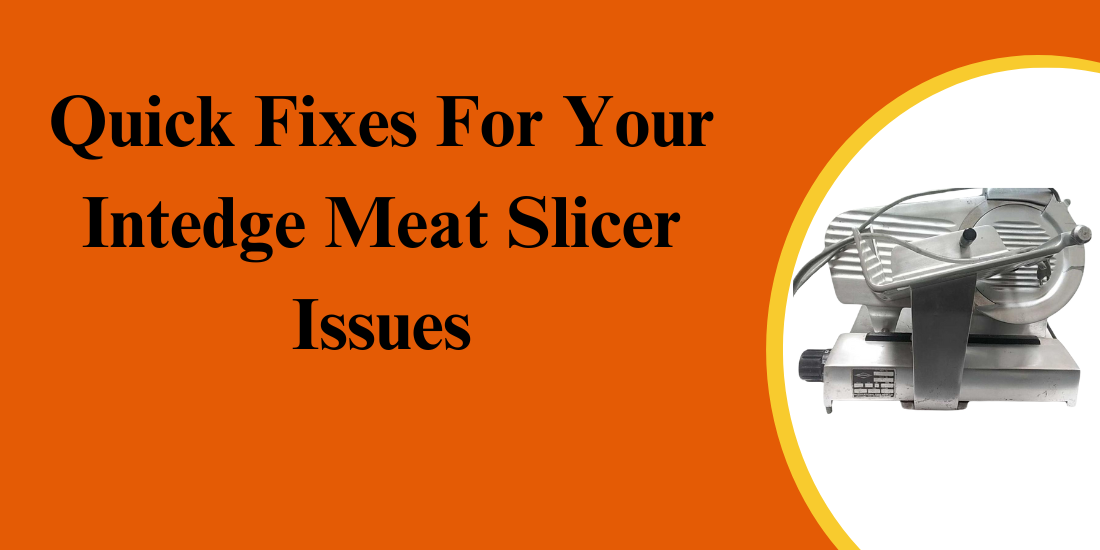
The Intedge Meat Slicer is a vital tool in many commercial kitchens, known for its precision and efficiency in slicing meats, cheeses, and vegetables. However, it may eventually encounter problems, just like any high-performance equipment. Identifying and addressing these problems promptly is crucial to ensure your kitchen runs smoothly. Whether the issue involves the Intedge Meat Slicer parts or other components, knowing how to fix common problems can keep your slicer operating efficiently. This article highlights some of the most common issues and offers practical solutions to get your slicer back to work.
Common Causes & Quick Fixes for Intedge Meat Slicer Issues
Here are some common causes and quick fixes for Intedge Meat Slicer problems, to help you address these issues promptly and get your slicer back to work.
1. Blade Not Spinning Properly
If you notice that the blade on your Intedge Meat Slicer is not spinning correctly, it can lead to poor slicing performance. The problem might be as simple as a dirty or dull blade, or it could be a sign of more serious issues with the motor or drive belt.
Potential Causes:
- Dull or dirty blade.
- Faulty motor or drive belt.
- Lack of lubrication in the blade assembly.
Quick Fixes:
- Clean the Blade: Disconnect the slicer and carefully clean the blade to remove any buildup of grease or food debris. Use a food-safe cleaner for best results.
- Sharpen the Blade: If the blade is dull, sharpen it using the built-in sharpener or a sharpening stone. If the blade is heavily worn, consider replacing it .
- Lubricate the Blade Assembly: Apply food-safe lubricant to the blade shaft and other moving components to ensure smooth operation.
- Check the Motor and Drive Belt: Open the housing and inspect the motor and drive belt for wear. Replace them if necessary.
2.Uneven or Inconsistent Slicing
Uneven slicing can be frustrating and result in wasted food, as well as a lack of consistency in presentation. If your Intedge Meat Slicer is cutting unevenly, it could be due to several factors related to the blade, thickness control, or even the carriage bearings.
Potential Causes:
- Misaligned blade.
- Incorrectly set thickness control knob.
- Worn-out or loose carriage bearings.
Quick Fixes:
- Check the Thickness Control Knob: Ensure the knob is set correctly and not stuck or loose. Adjust the setting to the desired thickness.
- Realign the Blade: If the blade is misaligned, carefully adjust it in line with the manufacturer’s directions. If you are unsure of how to do this, consult the user manual or an expert.
- Tighten the Carriage Bearings: Check for any loose or worn-out carriage bearings. Tighten or replace them with new Intedge Meat Slicer parts to restore smooth movement.
3.Meat Slicer Won’t Turn On
A meat slicer that won’t turn on is one of the most frustrating issues, as it can bring your kitchen operations to a halt. This problem could be caused by several things, including fuses, the power supply, or even bad internal wiring.
Potential Causes:
- Power supply issues.
- Blown fuse or tripped circuit breaker.
- Faulty on/off switch or internal wiring.
Quick Fixes:
- Check the Power Source: Make sure the slicer is plugged in and the power outlet is working. If the outlet is in good shape, check the power wire for any visible damage.
- Locate the fuse compartment and check to see if the fuse has blown.Change it out for a fuse with the appropriate voltage.
- Make sure the on/off switch is functioning properly; if not, it could need to be replaced. To guarantee safe handling and correct installation of a new switch, seek professional advice.
4.Excessive Noise During Operation
Unusual or loud noises from your Intedge Meat Slicer can indicate that something is wrong internally. These noises can be a result of insufficient lubrication, loose parts, or worn-out bearings.
Potential Causes:
- Lack of lubrication.
- Loose or damaged components.
- Worn-out bearings or motor.
Quick Fixes:
- Lubricate Moving Parts: Use a food-safe lubricant to lubricate all moving parts to reduce noise and friction. Ensure the blade and other components are properly lubricated.
- Tighten Loose Screws: Inspect the slicer for any loose screws or components and secure them with a wrench or screwdriver.
- Replace Worn Bearings: Look for wear on the bearings if the noise continues. Replace them with new ones to restore quiet operation.
5.Difficulty Moving the Food Carriage
If the food carriage is hard to move, it can make slicing more difficult and time-consuming. A stiff or jammed carriage can be caused by food debris or a malfunctioning track.
Potential Causes:
- Debris in the carriage track.
- Damaged or bent carriage track.
Quick Fixes:
- Clean the Carriage Track: Disconnect the slicer and thoroughly clean the carriage track to remove any food particles or grease that may have accumulated.
- Look for damage on the carriage track: Look for any bends or misalignments in the track. Take into consideration replacing the track if it is damaged.
You can make sure your Intedge Meat Slicer stays a dependable kitchen tool by using the troubleshooting advice and fixes provided in this article. Regular attention to potential issues and the timely replacement of worn-out parts will extend the lifespan of your slicer, ensuring it continues to deliver precise and consistent cuts for years to come.







